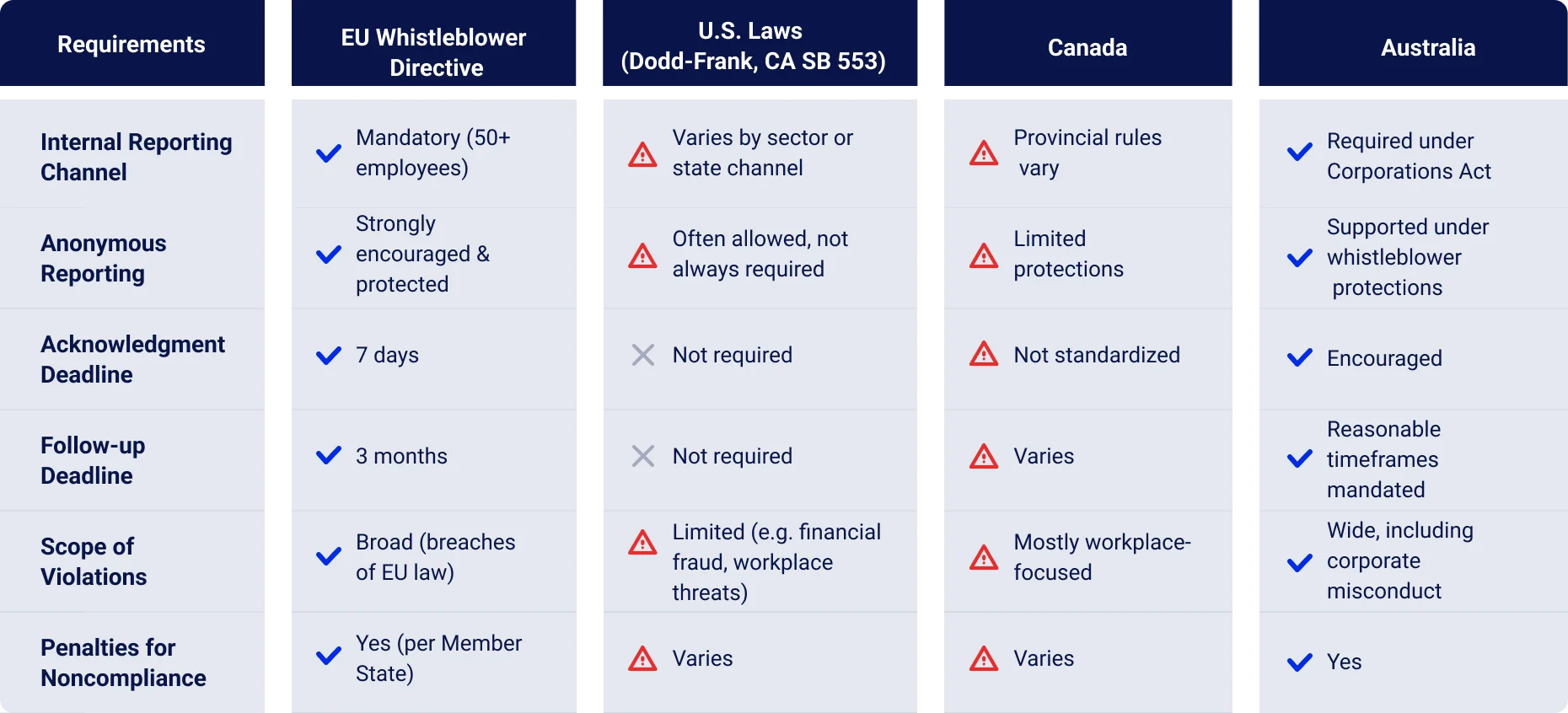Whistleblowing Compliance: Managing Multi-Jurisdiction Reporting in the EU, U.S., and Beyond
Whistleblowing laws differ significantly between regions like the EU, U.S., and California. Managing cross-border compliance requires adapting to each jurisdiction’s rules on anonymity, reporting timelines, and internal procedures. This article explains the challenges of global whistleblowing compliance, key differences between major frameworks, and how businesses can streamline secure, region-specific reporting workflows with centralized oversight.
When a company operates in more than one country, managing whistleblowing isn’t just a matter of adding a form to your intranet. It requires legal sensitivity, accessible and secure reporting channels, and respect for whistleblower rights across different frameworks.
So how can organizations retain centralized visibility while adapting to regional legal requirements? This article explores the complexities of multi-jurisdiction whistleblowing, what key laws mandate, and how tools like Clym’s whistleblowing solution can simplify global case management.
Why global whistleblowing compliance is complex
Global companies face a range of legal frameworks. In the EU, the Whistleblower Directive (Directive (EU) 2019/1937) applies to companies with 50 or more employees and includes requirements such as anonymous channels, 7-day acknowledgment deadlines, and 3-month follow-up.
In contrast, the U.S. lacks a single national standard. Instead, rules differ by sector and state:
- The Dodd-Frank Act covers securities violations, offering protections and financial incentives for whistleblowers.
- California SB 553 mandates anonymous reporting mechanisms for workplace violence and harassment.
Staying aligned with both local and international standards is often a balancing act.
Key differences in whistleblowing laws

Common Global Whistleblowing Challenges
- Regulatory fragmentation—one size doesn’t fit all.
- Limited localization—barriers for non-native speakers and persons with disabilities.
- Anonymity inconsistencies—EU encourages it, U.S. states vary.
- Balancing oversight and localization—visibility vs. data protection.
- Scalability—manual systems become inefficient across multiple regions.
Each of these challenges, if not addressed, can lead to noncompliance, lower employee trust, or ineffective reporting systems.
Key features of an effective global whistleblowing solution
- Location-based workflows tailored to regional laws.
- Multilingual and accessible interfaces.
- Role-based access to protect sensitive data.
- Anonymous reporting options with encryption.
- Case tracking, audit logs, and timely notifications.
Features like these transform whistleblowing systems from a compliance burden into a tool for building transparency and trust.
Cross-Border Workflow in Action
Imagine a business operating in Germany, California, and Texas:
- A California employee reports a workplace threat in Spanish via an anonymous form. The system applies SB 553 protocols, triggering a safety review.
- An engineer in Germany submits a report protected under the EU Directive, with required acknowledgment and follow-up timelines.
- Headquarters tracks both cases in one centralized dashboard, staying aligned with local rules while maintaining oversight.
Only a dynamic, jurisdiction-aware platform makes this possible. A centralized yet region-specific approach helps businesses meet legal obligations while protecting whistleblowers.
Best Practices for Managing Whistleblowing Globally
- Map legal obligations for each jurisdiction.
- Build localized workflows with geo-specific access and deadlines.
- Provide anonymous, accessible, and multilingual reporting.
- Use centralized dashboards for real-time case tracking.
- Train reviewers on region-specific confidentiality rules.
- Maintain logs for audit and legal reviews.
- Use secure infrastructure for data handling.
- Review policies regularly to reflect legal updates.
Following best practices not only reduces legal risk but also strengthens whistleblower confidence and organizational transparency.
How Clym supports whistleblowing compliance
Clym’s whistleblowing solution helps organizations:
- Design workflows for the EU Directive, Dodd-Frank, and California SB 553.
- Provide multilingual, secure portals.
- Enable anonymous, GDPR-aligned submissions.
- Restrict access based on geography and role.
- Manage global reports from a single, audit-ready interface.
Don’t risk gaps in whistleblowing compliance. Manage secure, jurisdiction-specific reports from one dashboard. Book a demo today.
FAQ
Not mandatory, but strongly encouraged. Companies must process anonymous reports when they receive them. Failing to provide this option can discourage whistleblowers and damage trust in your reporting channels.
Only in specific sectors and states. For example, California SB 553 mandates anonymous internal channels for workplace violence. In other states, requirements vary widely, so mapping obligations is critical.
Acknowledge within 7 days and provide follow-up within 3 months. Missing these deadlines can result in penalties under Member State rules and erode whistleblower confidence.
No. It focuses on financial violations and employee retaliation in publicly traded companies. Other sectors may fall under state-specific whistleblower protections, so businesses need localized workflows.
Yes, if it supports local workflows, legal timelines, language preferences, and access restrictions. Tools like Clym allow workflows to be tailored to deadlines, languages, and reporting requirements across multiple jurisdictions.
Clym enables businesses to create workflows that align with local obligations, whether that’s EU Directive timelines, U.S. sector-specific rules, or California SB 553 reporting, while still maintaining centralized oversight.
Absolutely. Clym’s dashboard offers case tracking, deadline alerts, and full audit trails across all regions.
Yes. The platform includes pre-configured templates and intuitive tools to help teams localize quickly.
Under the EU Whistleblower Directive and GDPR, data should be retained only as long as necessary for investigation, audit, or legal defense. A secure, audit-ready archive ensures compliance while respecting data minimization principles.